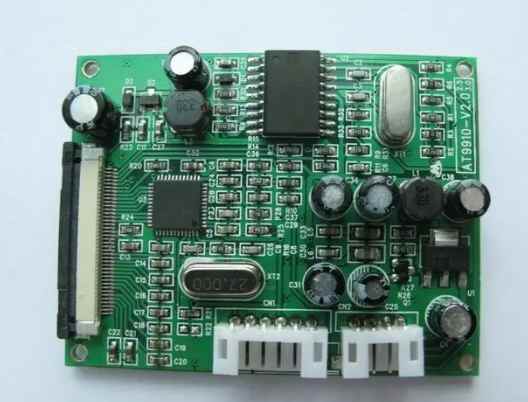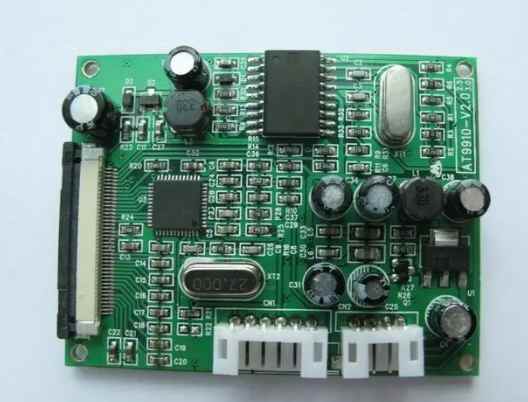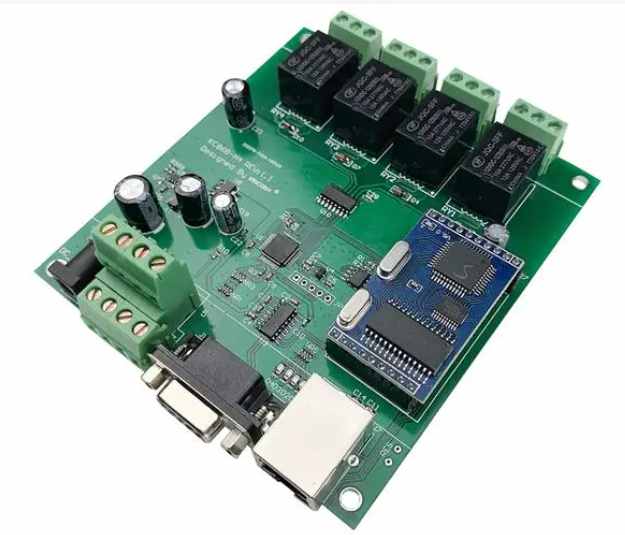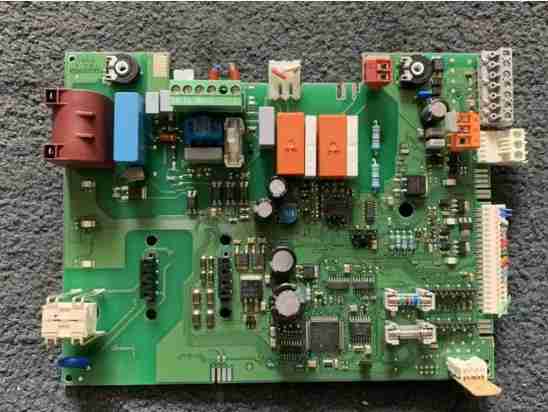
PCB Design Considerations For Switching Power Supply
In any switching power supply design, the physical design of the PCB board is the last link. If the design method is not proper, the PCB may radiate too much electromagnetic interference, resulting in unstable power supply.
First, from the schematic to create component parameters to PCB design process -> Input schematic netsheet -> Design parameter setting -> Manual layout -> Manual wiring -> Verify the design -> Audit -> CAM output.

Second, the spacing of adjacent conductors in the parameter setting must meet the electrical safety requirements, and the spacing should be as wide as possible to facilitate operation and production. Minimum spacing should be at least suitable for the voltage. When the wiring density is low, the spacing of the signal lines can be appropriately increased. The signal line with high and low level difference should be as short as possible, and the spacing should be increased. The general wiring spacing is set to 8mil. The distance between the inner hole edge of the pad and the edge of the printed board should be greater than 1mm to avoid defects in the pad during processing. When the wiring connected to the pad is fine, the connection between the pad and the wiring should be designed in the shape of a drop. The advantage of this is that the pad is not easy to peel off, but the wiring and pad are not easy to disconnect.
Practice has proved that even if the circuit schematic design is correct and the printing design is improper, it will have an adverse effect on the reliability of electronic equipment. For example, if the two thin parallel lines of the printed board are close together, a delay in the signal waveform will be formed, and reflected noise will be formed at the end of the transmission line. Interference caused by improper consideration of the power supply and ground wire can reduce the performance of the product. Therefore, the correct method should be used in the design of printed circuit boards. Each switching power supply has four current circuits:
(1) power switch AC circuit
(2) output rectified AC circuit
(3) input signal source current loop
(4) Output load current loop and input loop through the DC current to charge the input capacitor, filter capacitor mainly plays the role of broadband energy storage;
Similarly, the output filter capacitor is also used to store the high-frequency energy of the output rectifier, eliminating the DC energy of the output load circuit. Therefore, the terminals of the input and output filter capacitors are very important. The input and output current circuits can only be connected to the power supply from the terminals of the filter capacitor; If the connection between the input/output circuit and the power switch/rectifier circuit cannot be connected directly to the terminals of the capacitor, the AC energy will radiate through the input or output filter capacitor into the environment. Both the AC circuit of the power switch and the AC circuit of the rectifier contain high amplitude ladder current. The harmonic components of these currents are very high, and their frequencies are much higher than the basic frequency of the switch. The peak amplitude can be up to 5 times the continuous input/output DC current amplitude. The conversion time is usually about 50ns. These two circuits are the most prone to electromagnetic interference, so these AC circuits must be laid before other printed lines in the wiring power supply. The three main components of each circuit, a filter capacitor, a power switch or rectifier, an inductor, or a transformer, should be placed next to each other. Reposition components so that the current path between them is as short as possible. The best way to establish a switching power supply layout is similar to its electrical design. The optimal design process is as follows: - Place the transformer - Design the power switch current circuit Output rectifier Design the current circuit - Control circuit connect the AC power circuit - Design the input current source circuit and input filter Design the output load circuit and output filter, according to the functional unit of the circuit, the layout of the circuit components should follow the following principles:
(1) First of all, consider the PCB size. When the PCB size is too large, the printed line is long, the impedance is increased, the anti-noise ability is reduced, and the cost is increased. If it is too small, the heat dissipation is poor, and the adjacent lines are susceptible to interference. The best shape for the board is rectangular, with an aspect ratio of 3:2 or 4:3. The distance between the components located at the edge of the board and the edge of the board is generally not less than 2mm.
(2) When placing the equipment, it is necessary to consider the welding in the future, not too dense.
(3) The core components of the functional circuit are centered and arranged around it. Components should be arranged evenly, orderly and compact on the PCB to minimize and shorten the leads and connections between components. The decoupling capacitor is as close to the VCC of the component as possible
(4) For high-frequency operating circuits, the distribution parameters between components should be considered. For general circuits, the components should be arranged in parallel as far as possible. This is not only beautiful, but also easy to assemble and weld, and easy to mass produce.
(5) Arrange the position of each functional circuit unit according to the circuit flow direction, so that the layout is convenient for the signal flow direction, and try to keep the signal direction consistent.
(6) The first principle of layout is to ensure the distribution rate of wiring. When moving components, pay attention to the connection of the flying wire, and put the components with wiring relationships together.
(7) Reduce the loop area as much as possible to suppress the radiation interference of the switching power supply
Fourth, the wiring switching power supply contains high-frequency signals. Any printed line on the PCB can act as an antenna. The length and width of the printed wire affect its impedance and inductance, which affects the frequency response. Even printed wires passing through the DC signal can couple to RF signals from adjacent printed wires, causing problems with the circuit (or even radiating interference signals again). Therefore, all printed wires that pass through AC current should be designed to be as short and wide as possible, which means that all components connected to the printed wires and other power cords must be placed close together. The length of the printed line is proportional to its inductance and impedance, while the width is inversely proportional to its inductance and impedance. The length reflects the wavelength to which the printed circuit responds. The longer the length, the lower the frequency of the printed line can send and receive electromagnetic waves, and the more RF energy can be radiated. According to the current of the printed circuit board, try to rent the width of the power cord to reduce the circuit resistance. At the same time, the direction of the power cord and ground wire is consistent with the direction of the current, which helps to enhance the anti-noise ability. Grounding is the bottom branch of the four current circuits of the switching power supply, which plays an important role as the common reference point of the circuit and is an important method to control interference. Therefore, the placement of the grounding wire should be carefully considered in the layout. The mixed use of various ground cables may cause unstable power supply.
Ground Wire Design Should Pay Attention to the Following points:
1. The correct selection of single point grounding Under normal circumstances, the common end of the filter capacitor should be the only connection point for other ground points and high current alternating current coupling. The ground point of the same level circuit should be as close as possible, and the power filter capacitor of this level circuit should also be connected to the ground point of this level, mainly considering that the current returned by each part of the circuit is variable, and the impedance of the actual flowing line will lead to the change of the ground potential of each part of the circuit and introduce interference. In this switching power supply, the inductance effect between its wiring and components is small, and the circulation formed by the grounding circuit has a greater impact on interference, so a point of grounding is used, that is, the power switching current circuit (the ground wire of several components in the ground circuit is connected to the ground pin, and the ground wire of several components in the output rectifier current circuit is also connected to the ground pin of the corresponding filter capacitor, Make the power supply work more stable and not easy to self-excite, if you can not do a single point, connect two diodes or a small resistor in the common ground line, you can connect a relatively concentrated copper foil.
2. Make the ground cable as thick as possible. If the grounding wire is very thin, the grounding potential will change with the change of current, resulting in the timing signal level of the electronic device is unstable, and the anti-noise performance is poor. Therefore, make sure that each high-current ground terminal uses the shortest and widest printed wire possible, and widen the width of the power supply and ground wire as much as possible. The ground wire should be wider than the power cord. Their relationship is: ground > Power Cord > The signal line. If possible, the width of the ground cable should be greater than 3mm, and a large area covering each layer can also be used as a ground cable. The unused part of the printed board is connected to the earth as a ground wire. The following principles must also be followed when wiring globally
(1) Wiring direction: From the welding surface, the arrangement direction of the components is as consistent as possible with the schematic diagram, and the wiring direction is consistent with the wiring direction of the circuit diagram. Because it is usually necessary to test various parameters of the welding surface in the production process, it is easy to check, debug and maintain in the production (note: it refers to the premise of meeting the requirements of circuit performance, machine installation and panel) layout.
(2) When designing the wiring diagram, the line should turn as little as possible, the width of the printed arc should not change, the line Angle should be more than 90 degrees, and the line should be as simple and clear as possible.
(3) No cross circuit is allowed in the printed circuit. Lines that may cross can be resolved by "drilling" or "winding". That is, have a lead "drill" through a gap at the foot of other resistors, capacitors, and triodes, or "wind" through one end of a lead that may cross. In special cases, how to make the circuit very complicated? In order to simplify the design, it is also allowed to use jumpers to solve cross-circuit problems. Because of the single panel, the in-line element is located on the top side and the surface-mount element is located on the bottom side, so the in-line element can be overlapped with the surface mount element in the layout, but the pad should be avoided.
3. The input and output ground of the switching power supply are low-voltage DC-DC. In order to feed the output voltage back to the primary of the transformer, the circuits on both sides should have a common reference point. Therefore, after the ground wire on both sides is laid with copper, it should be connected together to form a public ground wire
After checking the wiring design, it is necessary to carefully check whether the wiring design meets the rules formulated by the designer, and also confirm whether the rules formulated meet the requirements of the printed board production process. Generally, it is necessary to check whether the distance between wire, wire and component pad, wire and through hole, component pad and through hole, through hole and through hole is reasonable and meets the production requirements. Whether the width of the power cord and ground wire is appropriate, and whether there is a place in the PCB where the ground wire can be widened. Note: Some errors can be ignored. For example, the Outline part of some connectors is placed outside the board frame, and errors will occur when checking the spacing; In addition, copper should be re-coated each time wiring and holes are modified.
4. Review according to PCB checklist, including design rules, layer definition, line width, spacing, pad and hole Settings, focusing on the rationality of device layout, the routing of power and ground networks, wiring and shielding high-speed clock networks, as well as the placement and connection of decoupling capacitors.
5. Precautions for designing output photo files:
a. The output layer includes the wiring layer (bottom layer), screen printing layer (top screen printing and bottom screen printing), solder resistance layer (bottom solder resistance), drilling layer (bottom layer), and NC drilling file
The Bay. b. When setting the number of layers of the screen printing layer, do not select Part Type. Select the Outline, Text, and Linec of the top layer (bottom layer) and screen printing layer. When setting the layer of the screen printing layer, do not select Part Type, but select the outline, text, and lines of the top (bottom) layer and screen printing layer. d. When generating the drill file, use the default Settings of the PowerPCB and do not make any changes.







